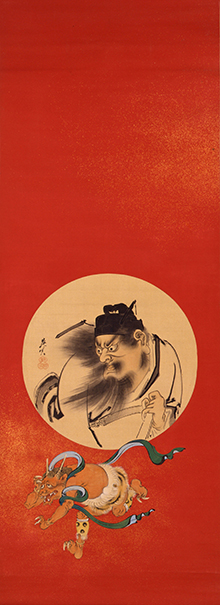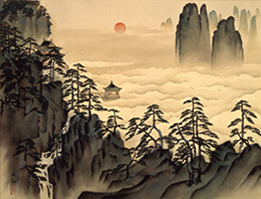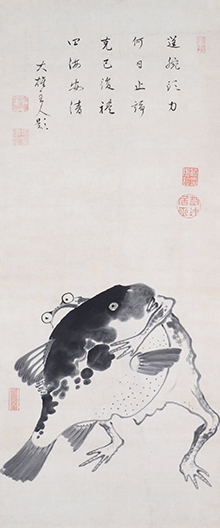 |
Focus features two in-depth reviews each month of fine art, architecture and design exhibitions and events at art museums, galleries and alternative spaces around Japan. The contributors are non-Japanese art critics living in Japan. |
|
|
 |
 |
 |
Inspirational Beauty at the Yamatane
Lucy Birmingham |
 |
Ito Jakuchu, Roosters and Hens (left panel), ink on paper, Edo period, c.1795 |
Across the world, from atrocities in Syria to mass shootings in the U.S., images of violence and tragedy dominate our media coverage. There's plenty to feel down about, and escaping the negative news onslaught seems an impossible task.
|
 |
|
|
|
Ito Jakuchu, Budai, the God of Contentment and Happiness, ink on paper, Edo period, 18th century |
|
|
|
 |
|
|
|
Shibata Zeshin, Zhong Kui, color on silk, 19th century (between late Edo and early Meiji periods), Yamatane Museum of Art |
And yet, a respite does exist in Japan at this time of year. The New Year is when museums, temples, shrines and other institutions throughout the country place auspicious and inspirational imagery on view. One such venue is the Yamatane Museum of Art in Hiroo, Tokyo, where a 50th-anniversary exhibition is inducing smiles and inspiring thoughts of strength and beauty.
The show's headliner is mid-Edo-period master Ito Jakuchu (1716-1800), with 11 works on display that celebrate the 300th anniversary of his birth. Also spotlighted is Yokoyama Taikan (1868-1958), who is credited with founding the Nihonga art movement. Nihonga, or "Japanese-style painting," is a compilation of traditional techniques and materials that emerged in the Meiji period (1868-1912) when Western-style painting was gaining influence in Japan.
Jakuchu's wide appeal can be credited not only to his vibrant and charming work but also the American art collector Joe Price and his keen eye for undiscovered masterpieces. Price's first art purchase in 1953 was a delicate Jakuchu drawing of grapevines found in a Manhattan gallery. The 23-year-old was escorting Frank Lloyd Wright back to his hotel when the great architect stepped into the gallery to take a look at some Japanese woodblock prints.
Price was hooked by Jakuchu's enchanting imagery but had no knowledge of Japanese art -- or any other art, for that matter. At the time, "nobody knew Jakuchu's name," he says in a published interview. "I found out his name when I came across a book with reproductions of 30 pictures of his. And they're the most beautiful paintings ever painted, I think."
Later, with his wife Etsuko, Price built up an astonishing collection of 600 paintings by Edo-period artists. The Etsuko and Joe Price Collection includes the largest private assemblage of Jakuchu's works. "My collection gave my life a new purpose, for I wanted the public to experience for themselves the same immense joy that this art has brought to me," Price wrote ahead of an exhibition at the U.S. National Gallery of Art in 2012. "I want everyone to examine the differences between the great masters, their gifted students, and those that, in the process of learning, attempted to copy their works. The Etsuko and Joe Price Collection is not intended to be seen as just a collection -- it hopefully should be an experience."
A similar experience can be had at the Yamatane Museum, which boasts over 1,800 items (focusing on Edo-period and Nihonga works). The ongoing show until March 3, Jakuchu's Happiness and Taikan's Auspiciousness, includes several of Jakuchu's iconic ink paintings of animals and humorous monochrome sketches of "lucky gods" (which would go well with Pharrell Williams's song "Happy" if there were a much-needed English audio guide).
Favorites include Roosters and Hens (c.1795), Fushimi Dolls (1799), and Sumo Match Between a Globefish and a Frog (18th century), the last of which greets visitors at the entrance to the show. The inscription above the two grappling creatures reads: "When will the struggles end?" It's said that the artist is poking fun at a conflict in his own daily life. Indeed, laughter at life and its incessant challenges is the best medicine.
 |
|
 |
|
Yokoyama Taikan, The Enchanted Mt. Penglai on the Island of Eternal Youth, color on silk, c.1939, Yamatane Museum of Art |
|
Yokoyama Taikan, Divine Spirit: Mt. Fuji, ink and light color on silk, 1952, Yamatane Museum of Art |
Yokoyama Taikan's paintings on display include his stunning landscapes of Mt. Fuji and Mt. Penglai, a mystical peak found in Chinese mythology and adapted into Japanese myth. His combinations of pine, bamboo and plum are a popular theme in East Asian art. This sho-chiku-bai triad is symbolic of steadfastness and resilience, as all three species can survive the winter season.
Shimomura Kanzan, Shoulaoren, the God of Longevity, color on silk, c.1920, Yamatane Museum of Art |
|
Kobayashi Kokei, Crane, color on paper, 1948, Yamatane Museum of Art |
For a unique peek into the life of Taikan, you can peruse an unpublished article, available online, by Indian graphic artist Mukul Dey about his time with the artist, already commercially successful, in 1916. "Yokoyama Taikan: As I Knew Him" is dated 1958, the year Taikan passed away.
|
 |
|
|
|
Ito Jakuchu, Sumo Match Between a Globefish and a Frog, ink on paper, Edo period, 18th century |
Dey writes, "Mt. Fujiyama in all her moods was one of his favourite and most sacred subjects and the one upon which his fame mainly rested . . . Apart from teaching, it was his habit to travel about the countryside in a rickshaw, studying nature and gaining inspiration for his next big picture for the annual exhibition at Nippon Bijutsu-in. He was so unique and outstanding an artist that he would limit himself to one masterpiece per year in painting a large folding screen of many sections . . . When his annual painting was on view the whole of the art-loving public would crowd to see it. Everyone was keen to absorb the latest artistic ideas of this great artist, and the sum paid for this annual picture was not always readily forthcoming. But it was sufficient to keep him in comfort for the next twelve months."
Beyond Taikan and Jakuchu, the show delights with felicitous works such as Crane by Kobayashi Kokei. The red-crowned crane is the Japanese symbol of longevity and good luck. Shimomura Kanzan's Shoulaoren, the God of Longevity reveals the artist's great gift for expressing qualities not normally combined -- here, majesty and gentleness. A young deer with a tear in its eye rests its head on the lap of the lofty deity.
 |
|
 |
|
Ito Jakuchu, Fushimi Dolls, color on paper, Edo period, 1799, Yamatane Museum of Art |
|
Shibata Zeshin, Urushi-e Lacquer Painting Album "Bokurin Hikka", lacquer on paper, Meiji period, 1877-88, Yamatane Museum of Art |
My favorite is Kawasaki Shoko's The Advent of Spring, a dream-like landscape inspired by the legend of Sahohime, the Goddess of Spring, in Japanese myth. As Sahohime sprinkles flowers from Mt. Saho, east of Nara, the winter hills and plains come to life, evoking hope and renewal. Viewing the painting may offer only a brief respite from the hardness of life, but the visual memory of its inspiring message can last forever.
All images courtesy of the Yamatane Museum of Art.
|
 |
| | The 300th Anniversary of the Birth of Ito Jakuchu
Jakuchu's Happiness and Taikan's Auspiciousness:
All Happiness Comes to the Homes of Those Who Smile |
| | Yamatane Museum of Art |
| | 3 January - 3 March 2016
Note: The commemoration of the 50th anniversary of the Yamatane Museum will include seven shows from 19 March 2016 to 16 April 2017. |
|
 |
 |
Lucy Birmingham
Lucy Birmingham is a long-time, Tokyo-based journalist, scriptwriter, author, and former photojournalist. She recently served two years as president of the Foreign Correspondents' Club of Japan. She has written regularly for TIME magazine and her articles have appeared in many publications, including the Wall Street Journal, Newsweek, Bloomberg News, and Architectural Digest. As an arts and culture writer her articles have appeared in publications including Artinfo.com, Artforum.com, and ARTnews. She is also a scriptwriter and narrator for NHK (Japan's public broadcaster) and has published several books including Strong in the Rain: Surviving Japan's Earthquake, Tsunami, and Fukushima Nuclear Disaster. lucybirmingham.com |
|
 |
|